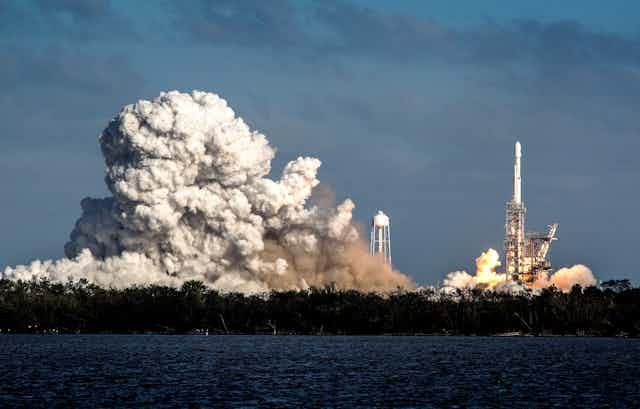Two controversial objects have recently been launched in space, and their messages couldn’t be more different.
One is Elon Musk’s red sports car, a symbol of elite wealth and masculinity, hurtling towards Mars.
The other is a glittering geodesic sphere in Earth orbit, designed to give humans a shared experience and a sense of our place in the universe: the Humanity Star.
Read more: Trash or treasure? A lot of space debris is junk, but some is precious heritage
A red car for a red planet
On February 6 2018, Musk’s private space company SpaceX launched the much-vaunted Falcon Heavy rocket from Kennedy Space Centre – from the same launch pad as Apollo 11 in 1969.
It’s a test launch carrying a dummy payload: Musk’s own personal midnight cherry Roadster, a sports car made by his Tesla company. The driver, dubbed Starman, is a mannequin in a SpaceX spacesuit.
Read more: Elon Musk is launching a Tesla into space – here's how SpaceX will do it
For the ultimate road trip soundtrack, the car is playing David Bowie’s Space Oddity.
The car will enter an elliptical solar orbit, its furthest point from the Sun around the distance of Mars.
Musk thinks of it as future space archaeology.
Reactions include waxing lyrical about the speed the car will reach, lamenting the lost opportunity for a scientific experiment, and celebrating it as an inspirational act of whimsy.
Fear of flying
The Tesla Roadster might be an expendable dummy payload, but its primary purpose is symbolic communication. There’s a lot going on here.
There’s an element of performing excessive wealth by wasting it. Giving up such an expensive car (a new model costs US$200,000) could be seen as a sacrifice for space, but it’s also like burning $100 notes to show how little they mean.
In the 1960s, anthropologist Victor Turner argued that symbols can encompass two contradictory meanings at the same time. Thus, the sports car in orbit symbolises both life and death. Through the body of the car, Musk is immortalised in the vacuum of space. The car is also an armour against dying, a talisman that quells a profound fear of mortality.
The spacesuit is also about death. It’s the essence of the uncanny: the human simulacrum, something familiar that causes uneasiness, or even a sense of horror. The Starman was never alive, but now he’s haunting space.
In a similar vein, the red sports car symbolises masculinity – power, wealth and speed – but also how fragile masculinity is. Stereotypically, the red sports car is the accessory of choice in the male mid-life crisis, which men use to rebel against perceived domestication.
A related cultural meme holds that owning a sports car is over-compensation. Have we just sent the equivalent of a dick pic into space?
Space graffiti
The brainchild of Peter Beck (founder of the New Zealand-based Rocket Lab), the Humanity Star was launched on January 21 2018, but kept a secret until after it had successfully reached orbit.
In contrast to the lean and slightly aggressive lines of the sports car, the Humanity Star is a geodesic sphere of silver triangular panels. It’s a beach ball, a moon, a BB8, a space age sculpture. Its round shape is friendly and reassuring.
Similar satellites – with reflective surfaces designed for bouncing lasers – are orbiting Earth right now. But this satellite doesn’t have a scientific purpose. Its only function is to be seen from Earth as its bright faces tumble to catch the light.
Astronomers weren’t happy, saying that it would confuse astronomical observations. It was even called “space graffiti”, implying that its visual qualities marred the “natural” night sky. Some lambasted Rocket Lab for contributing to the orbital debris problem. Instead of inspiration, they saw pollution.
Through the looking glass
Beck wants people to engage with the Humanity Star. In his words,
My hope is that everyone looking up at the Humanity Star will look past it to the expanse of the universe, feel a connection to our place in it and think a little differently about their lives, actions and what is important.
Wait for when the Humanity Star is overhead and take your loved ones outside to look up and reflect. You may just feel a connection to the more than seven billion other people on this planet we share this ride with.
Read more: Looking up a century ago, a vision of the future of space exploration
This is the “Overview Effect” in reverse. We can’t all go to space and see the whole blue marble of the Earth from outside, inspiring a new consciousness of how much we are all together in the same boat. Beck has tried to create a similar feeling of a united Earth by looking outwards instead.
In nine months or so, the Humanity Star will tumble back into the atmosphere to be consumed. It will leave no trace of its passage through orbit.
The medium is the message
Ultimately, these orbiting objects are messages about human relationships with space. Both objects were launched by private corporations, inviting Earthbound people to share the journey. However, one reinforces existing inequalities, while the other promotes a hopeful vision of unity.
Beck and Musk’s intentions are irrelevant to how the symbols are interpreted by diverse audiences. Symbols can be multivalent, contradictory, and fluid – their meanings can change over time, and in different social contexts.
Every object humans have launched into the solar system is a statement: each tells the story of our attitudes to space at a particular point in time.

